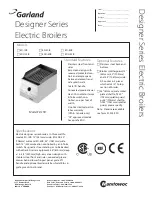
© MHG Heating Ltd
96
MHG Heating Ltd Unit 4 Epsom Downs Metro Centre, Waterfield, Tadworth, Surrey KT20 5LR
Telephone 08456 448802 Fax 08456 448803 Email
Web www.mhgheating.co.uk
010711
If dis-colouration has occurred, then specialist de-scaling of the heat exchanger will be required, however,
stress cracking may have occurred, and the heat exchanger may become porous following the de-scale
works.
h)
If the heat exchanger has not suffered from dis-colouration, as ‘Item g’ above, then a Standard Service can
be undertaken. Using a natural bristled brush ONLY, remove the worst of the mineral/debris build up.
With the use of the dissolved
ProCon Combustion Chamber Cleaning Granules
, spray the solution onto the
heat exchanger surface and leave for approximately 5 minutes. This will help to remove any stubborn
mineral deposits and clear the condensate drain connections. Finally brush the heat exchanger whilst
rinsing thoroughly with copious amounts of fresh water.
ProCon Combustion Chamber Cleaning Granules
are available from MHG Heating Ltd Spares Department. A STEEL OR PVC BRUSH MUST NOT BE USED TO
CLEAN THE HEAT EXCHANGER.
i)
Following the cleaning of the Heat Exchangers, the condensate syphon must be flushed to ensure that all
mineral deposits/debris that has been washed from the heat exchanger surface is correctly removed. Open
the syphon cleaning point cap at the base of the boiler, with a suitable receptacle directly below to collect
the syphon contents. Safely dispose of the contents of the syphon. Replace the receptacle below the
cleaning point and poor 2 litres of clean tap water into the heat exchanger, which will drain through the
cleaning point. Refit the cleaning point cap and poor half a litre of clean tap water into the heat
exchanger to ensure the syphon is re-flooded. Check the cleaning point cap for leaks.
j)
Visually check the burner surface for signs of damage and debris build-up. Remove any debris build up with
compressed air. If excessive debris build-up is identified, the burner lance should be removed and the inner
metal surface should be washed and cleaned. A BRUSH, OF ANY KIND, MUST NOT BE USED TO CLEAN THE
BURNER SURFACE. If damage has occurred to the burner surface, the burner MUST be replaced.
k)
To ensure that the rectification circuit operates correctly the resistance between the burner and burner
door must be check with a multi-meter to ensure that it is less than 1 Ohm (<1 Ohm.)
l)
Clean with abrasive material and inspect the ignition electrode. Replace if necessary. Adjust the spark gap
to 4mm.
m)
Check the combustion fan blades for debris build-up. Remove any debris with a soft bristle brush or
preferably compressed air. DO NOT TOUCH, OR SPIN, THE FAN BLADES WITH YOUR FINGERS AS THIS
COULD AFFECT THE BALANCING OF THE FAN BLADES.
n)
Re-fit the Burners, in the reverse order of dismantling, ensure that all electrical connections are correctly
and securely connected.
o)
Inspect all water joints. Any joints found to be leaking MUST be replaced. It is also advisable when replacing
water joints to also change any adjacent joints at the same time.
p)
Inspect all gas joints with a suitable leak detection method. Any joints found to be leaking MUST be
replaced. It is also advisable when replacing gas joints to also change any adjacent joints at the same time.
q)
Via the tappings on the boiler connector elbow or straight a flue gas recirculation check must be
undertaken when the boiler is operating on high and low fire modes.
r)
Inspect and clean the condensate neutralising tank, replenishing the neutralising granules as required.
Granules available from MHG Heating Ltd Spares Department.
s)
With the use of a suitable Flue Gas Analyser, check and adjust the combustion settings, as detailed in
Section 15.2.
t)
Inspect the general condition of the flue system, including the termination, repair as necessary or advise on
any remedial action as required.
u)
Following the satisfactory completion of the above service procedure, the internal Routine Service Control
Timer needs to be reset. Utilising the appliances fascia gain access to the Second Level Parameters, as
detailed in Section 14.2, and select Parameter Line H630 – Bit 6. using the + button, adjust the value from 0
to 1 and press the INFO button to reset the Service Interval counter.
19.0 Weather Compensation Slope
















































